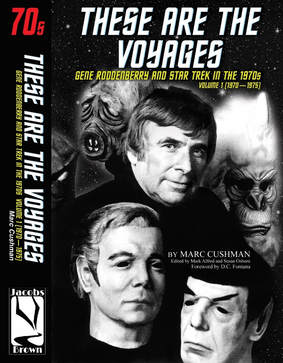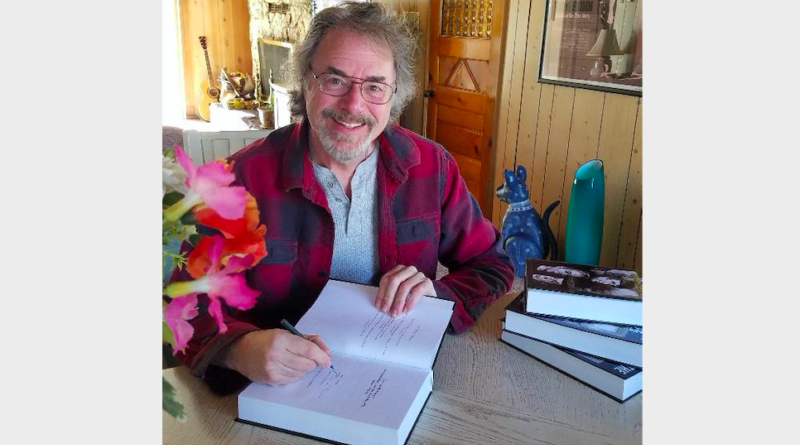INTERVIEW: ‘Star Trek’ fans rejoice! New audio book dissects ‘TOS’ season one
Photo: Marc Cushman is the author of These Are the Voyages. Photo courtesy of the author / Provided by press agent with permission.
Star Trek fans, sometimes lovingly called Trekkies or Trekkers, have remained dedicated to the franchise for decades. Whether there are those who remember watching The Original Series in the 1960s or fans who are digging Star Trek: Discovery on CBS All Access, the enthusiasts around the world live and breathe Spock, Bones, Scotty, Uhura, Sulu, Chekov and, of course, Captain Kirk.
Now those fans can relive some of the behind-the-scenes stories of Gene Rodenberry’s creation. A new audio book, running 28 hours long, details the first season of TOS.
The project, dubbed These Are the Voyages — Star Trek: The Original Series: Season One — is the brainchild of Marc Cushman, who wrote a book a few years back with the same title. These 28 hours delve into the first set of episodes, which introduced the fanbase to many iconic characters. There are stories about the two pilots, the Gorn and Captain Pike, to name but a few.
Cushman employed Vic Mignogna, a voice actor, as the principal reader for the audio book. There are also numerous guest performers, including Adam Nimoy, Leonard Nimoy’s son; Chris Doohan, James Doohan’s son; and even Rod Roddenberry, Gene’s son. Another highlight is the addition of D.C. Fontana, a writer on TOS, reading from her memos to the other writers in the 1960s.
Recently Hollywood Soapbox exchanged emails with Cushman. Questions and answers have been slightly edited for style.

For Trek fans, what can they expect from the These Are the Voyages audio book?
To go back in time; to witness the creation of Star Trek and the making of its two pilot films and the rest of the 28 episodes from its formative first season.
First, this is a reading of These Are the Voyages — Star Trek: The Original Series: Season One, which won a Special Achievement Saturn Award. Leonard Nimoy said of the book, ‘the research is astounding.’
This, and its two companion books, Season Two and Season Three, are the definitive documentation on the making of Star Trek. The reason for this is that the people who made Star Trek contributed to these books. Over a hundred people were interviewed, and hundreds of archival interviews fill in for those who could not participate.
And then there are the memos, the production reports, the budget reports and the Nielsen TV ratings, for every episode. We had tens of thousands of documents that Gene Roddenberry, Robert Justman, John D.F. Black and Dorothy Fontana — the writer/producers of Star Trek — had saved and contributed to this project. By use of the interoffice memos alone, you feel you are sitting in the writers room in 1966 and ’67, listening to the creative staff discuss each script being written, including one’s that were never filmed.
You are at the casting sessions. Then you are taken onto the sound stage to witness the episodes being made, seeing what went right and what went wrong. You are there when the episodes first air over NBC, and you see the reviews, the ratings and even a sampling of the fan letters that came in after the broadcasts. That’s how the books work — and these books are 700 pages each! There is a chapter for every episode. And this is now how the audio book works.
This new audio production — just for the creation of Star Trek and its first season — is 27 hour[s] long! We call it an audio book, but it is actually an audio play, for it has a cast of nearly 100, including many of the original participants from the making of Star Trek.
This includes Star Trek writer and story editor D.C. Fontana, reading her own memos from 1967-67, and speaking her quotes from the book; and former child actor Clint Howard, who played Commander Balak in the classic Corbomite Maneuver episode, telling you about his experience on Star Trek; and casting director Joe D’Agosta, director Ralph Senensky, actor Sean Kenney, who played the crippled Captain Pike in the Hugo Award-winning episode The Menagerie, and on and on.
For the people who we could not have record their own parts, either because of logistics, age or, sadly, their having passed on, we brought in voice actors to speak for them, or, in some cases, off-spring.
For instance, Adam Nimoy speaks for his dad, Leonard Nimoy; Chris Doohan — who plays Scotty on Star Trek Continues — speaks for his dad, the original Scotty, James Doohan. Rod Roddenberry, son of Star Trek creator and producer Gene Roddenberry, is also present.
The primary reader, who reads all of the author’s words, is Vic Mignogna, executive producer and star of Star Trek Continues. He plays Captain Kirk there, and he is our captain for this audio journey. He produced the audio play, as well, a task which took nearly a full year.
End results, you aren’t just hearing the story of Star Trek;you are living it. You will be taken there.
How difficult was the research into this expansive project?
The research alone spanned three decades. I began in 1982, with Gene Roddenberry, who contributed all the scripts — first and final drafts, as well as tens of thousands of other documents. Co-producer Robert Justman came next. Then associate producer John D.F. Black. Then story editor Dorothy Fontana. They were the architects of Star Trek.
Then I moved on, interviewing cast members, guest players, production crew members, studio people, network people, anyone and everyone I could find who helped make that show. I also gathered together thousands of archival items, such as newspaper articles, reviews, interviews from the 1960s, etc.
And I did all this while working as a screenwriter and director in Los Angeles. So, this was a weekend job, that lasted for hundreds of weekends between 1982 and 2008. It was in 2008 that I stated putting it all together, and it took a year to write each of the three volumes that comprise this book series.
Then I had Robert Justman, John D.F. Black and Dorothy Fontana read them and addressed their notes. Then we edited and illustrated, with hundreds of rare pictures in each book. Finally, the first volume — Season One — was ready to be published in 2013. The second went to print in 2014 and the third in 2015.
What does this first release cover as far as the Star Trek timeline?
Besides covering the creation of the series, then the making of the two pilot films, and all the first season episodes, the first book also covers the early life and career of Gene Roddenberry, and the other key players, including the stars of the series. And, included in documenting the making of the pilots and the first season, we see the battles between Roddenberry and NBC, over every episode.
This fight builds as we move into Season Two and Three, and contributes to the cancellation of Star Trek. The show was tackling subjects and themes that were not allowed in entertainment primetime shows back then. As stated earlier, we also see the ratings for every episode, and, this alone, dispels a sensational myth that has been spread for five decades — that Star Trek was a failure in the ratings while on NBC. Its numbers were not as bad as we have been led to believe. What was bad, and what got worse with each year, was the relationship between Roddenberry and the network.
And what Star Trek cost it maker — Lucille Ball and Desilu Studios. Lucy’s board of directors told her not to make Star Trek — that it would be too expensive and could bust the studio. She ignored them. Halfway through Star Trek’s second season, Desilu ran out of money and had to be sold to Paramount. It not only broke the studio, it broke Lucille Ball’s heart.
Will there be future audio books on other parts of the Star Trek franchise?
That depends on how the first one does. I can’t imagine there will not be. Whether Vic will ever want to work this hard again or not, I’ll leave for him to answer. Vic?
When did you first fall in love with Star Trek?
I fell in love with it the night I first saw it, which was in the summer of 1967, when I saw a rerun on NBC of The Devil in the Dark, the classic Horta story. As I saw more episodes, that love grew deeper. It wasn’t just that Star Trek was imaginative and entertaining — we had lots of shows like that in the mid-1960s. But it affected me in another way. The tone of the stories — the themes — really got to me.
I’d find myself thinking about it after watching each episode. These shows had something to say, and they not only got me thinking, but feeling as well. I learned a lot from Star Trek — about myself and the entire human race. I can’t say that I ever learned more from another TV series.
Star Trek and The Beatles — we had an embarrassment of riches back then, didn’t we?
By John Soltes / Publisher / John@HollywoodSoapbox.com
These Are the Voyages — Star Trek: The Original Series: Season One is now available. Click here for more information.

